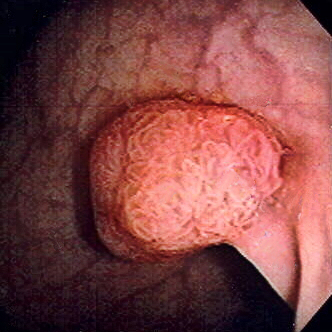Colorectal Polyp
A colorectal polyp is a fleshy growth occurring on the lining of the colon or rectum. Untreated colorectal polyps can develop into colorectal cancer. These polyps are classified based on their behaviour (benign vs. malignant) or cause (such as a consequence of inflammatory bowel disease).
They range from benign (e.g., hyperplastic polyp), pre-malignant (e.g., tubular adenoma), to malignant (e.g., colorectal adenocarcinoma).

Overview
Colorectal polyps are often asymptomatic. When symptoms do occur, they include bloody stools, changes in stool frequency or consistency (such as prolonged constipation or diarrhoea), and fatigue due to blood loss. Anaemia from iron deficiency can also present without visible blood in stools.
Additionally, increased mucus production from villous adenomas can lead to potassium loss and symptomatic hypokalaemia. In severe cases, large polyps may cause bowel obstruction, resulting in nausea, vomiting, and severe constipation.
Signs and Symptoms
Polyps are either pedunculated (attached to the intestinal wall by a stalk) or sessile (growing directly from the wall). Histologically, they are categorised as tubular adenomas, villous adenomas, or tubulovillous adenomas.
Structure
Hereditary syndromes that increase the risk of colorectal polyp formation include:
- Familial adenomatous polyposis (FAP)
- Hereditary nonpolyposis colorectal cancer (Lynch Syndrome)
- Peutz–Jeghers syndrome
- Juvenile polyposis syndrome
Familial Adenomatous Polyposis (FAP)
FAP involves a mutation in the APC gene on chromosome q521, leading to early development of multiple polyps and eventual cancer if untreated. The gene is autosomal dominant, and patients typically are diagnosed around age 29, with colorectal cancer developing around age 39.
Hereditary Nonpolyposis Colorectal Cancer (Lynch Syndrome)
Lynch Syndrome is the most common hereditary colorectal cancer syndrome in the US, accounting for about 3% of cases. It involves early-onset cancer, often presenting around age 44, with a high occurrence of proximal lesions and good surgical outcomes.
Peutz–Jeghers Syndrome
This autosomal dominant syndrome involves hamartomatous polyps and increased pigmentation around the mouth, lips, and fingers. It is associated with the STK11 gene and increases the risk of both intestinal and extraintestinal cancers.
Juvenile Polyposis Syndrome
Characterised by multiple juvenile polyps, this syndrome is linked to malfunction of the SMAD4 gene. It presents with bleeding, obstruction, and an increased risk of intestinal and extraintestinal cancers.
Types

Colorectal polyps can be classified into:
- Hyperplastic
- Neoplastic (adenomatous and malignant)
- Hamartomatous
- Inflammatory
Diagnosis
Diagnosis can be made using various methods including faecal occult blood test, flexible sigmoidoscopy, colonoscopy, virtual colonoscopy, digital rectal examination, barium enema, or a pill camera. Malignant potential is associated with the degree of dysplasia, type of polyp, and size of the polyp.
Treatment
Polyps can be removed during a colonoscopy or sigmoidoscopy using a wire loop and cauterisation. Endoscopic mucosal resection (EMR) is used for large or difficult polyps. Minimally invasive surgery or colectomy may be indicated for polyps that cannot be removed endoscopically.
Follow-up
Follow-up intervals vary based on initial findings:
- Normal: 10 years
- 1–2 tubular adenomas <10 mm: 7–10 years
- 3–4 tubular adenomas <10 mm: 3–5 years
- 5–10 tubular adenomas <10 mm, adenoma ≥10 mm, adenoma with tubulovillous or villous histology, or adenoma with high-grade dysplasia: 3 years
- >10 adenomas: 1 year
- Piecemeal resection of adenoma ≥20 mm: 6 months
Gallery





Self-assessment MCQs (single best answer)
What is a colorectal polyp?
Which of the following is NOT a symptom of colorectal polyps?
Which genetic syndrome is associated with an increased risk of colorectal polyps and involves a mutation in the APC gene?
What type of adenoma is considered to have a high risk of malignant transformation?
Which diagnostic method is NOT commonly used to detect colorectal polyps?
What is the recommended follow-up interval for a patient with 1–2 tubular adenomas less than 10 mm in size?
Which hereditary syndrome is characterised by increased pigmentation around the mouth, lips, and fingers?
What type of polyp is most commonly benign?
Which of the following is a treatment option for colorectal polyps?
What is the most common histological type of dysplastic polyp in the colon?
Dentaljuce
Dentaljuce provides Enhanced Continuing Professional Development (CPD) with GDC-approved Certificates for dental professionals worldwide.
Founded in 2009 by the award-winning Masters team from the School of Dentistry at the University of Birmingham, Dentaljuce has established itself as the leading platform for online CPD.
With over 100 high-quality online courses available for a single annual membership fee, Dentaljuce offers comprehensive e-learning designed for busy dental professionals.
The courses cover a complete range of topics, from clinical skills to patient communication, and are suitable for dentists, nurses, hygienists, therapists, students, and practice managers.
Dentaljuce features Dr. Aiden, a dentally trained AI-powered personal tutor available 24/7 to assist with queries and provide guidance through complex topics, enhancing the learning experience.
Check out our range of courses, or sign up now!


